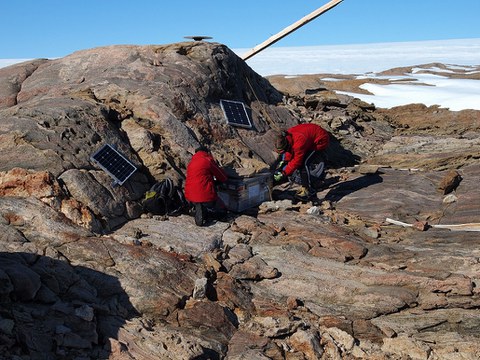Feb 23, 2022
In rock and ice: Tracing the millimetre

Arrival of the field team at the Russian Antarctic station Molodeshnaya. From left to right: Karl Heidrich-Meisner (TU Dresden), Sonja Berg (University of Cologne), Ole Bennike (GEUS Copenhagen), Maria Kappelsberger (TU Dresden), Niklas Leicher and Bernd Wagner (both University of Cologne).
The mass change of the Antarctic Ice Sheet leads to an uplift of the Earth's crust: to measure this, Maria Kappelsberger M.Sc. and Karl Heidrich-Meisner, PhD student and geodesy student, respectively, at the Chair of Geodetic Earth System Research at TU Dresden, were active on the Antarctic mainland.
Together with four Quaternary geologists from Cologne and Copenhagen, they conducted fieldwork in the Thala Mountains in Enderby Land, East Antarctica, for a fortnight from 2 February 2022.
On 14 February 2022, the group of six scientists was brought back on board the German research icebreaker "Polarstern". In the meantime, on its return voyage in the South Atlantic to the destination port of Cape Town (South Africa) "Polarstern" has reached a latitude that once again allows for greater bandwidths in satellite communication and, thus, the transmission of detailed information and photos.

Maria Kappelsberger (left) and Karl Heidrich-Meisner setting up the GPS station Blisnetzow. To recharge the batteries solar modules were used.
Maria Kappelsberger and Karl Heidrich-Meisner were able to realise geodetic GPS measurements for seven to ten days at three points which are marked by special bolts in bedrock. By a joint analysis with the data of the measurement campaigns repeatedly carried out since 2006, deformation rates of the solid Earth can be derived. In particular, we are interested here in the vertical deformation rate (or change in height), which is most strongly affected by the ice mass changes. "In doing so, we hope to achieve an accuracy level of 1 mm/year in order to be able to detect even small changes," says Dr Mirko Scheinert, senior scientist at the professorship and head of this project funded by the German Research Foundation (DFG). To record the change in ice mass, we don't just have to look at the present, we have to go back into the past - to the last glacial maximum, for example. In order to explore this climate history of the Holocene (and possibly even further back), the Quaternary geology colleagues drilled sediment cores in various lakes, which are then subjected to in-depth analyses at home.

GPS station ABE1 in the Thala Hills, Enderby Land, East Antarctica. In the right background one can see a timber signal which was used for classic geodetic measurements (triangulation).
In the working area, the six scientists were accommodated in a building of the Russian Antarctic station "Molodeshnaya", which was not occupied during this southern summer. However, they received active support from their colleagues at the Belarusian station "Gora Vechernyaya" (engl: “Evening Mountain”), which is located about 15 km away. "The operation to transport the people and scientific equipment from the ship to the working area in the Thala Mountains involved ten helicopter flights and took about ten hours," reports Kappelsberger. Due to sea ice cover, "Polarstern" had to take up position about 35 km away from Molodeshnaya. When “Polarstern” came back, the broken sea ice, which had been carried away or melted by the wind and currents to the north, allowed it to get as close as about 4 km. The three GPS measuring points, located between 1.5 and 18 km from the Molodeshnaya station, were reached by the two scientists with skidoos. "For this, it was essential that we had good weather conditions and sufficient contrast for good visibility," adds Heidrich-Meisner.

Overview map of Thala Hills with the Antarctic stations Molodeshnaya (Russia) and Goar Vechernyaya (Belarussia) and with the GPS stations. Background: optical image taken by the satellite Sentinel-2 (EU/ESA), acquisition date: 23-Jan-2022.
The cruise leg PS128 of the research icebreaker "Polarstern", which will end on 28 February 2022, is the first voyage within the multidisciplinary joint project "East Antarctic Ice Sheet Instability" (EASI). Mirko Scheinert is a co-PI in this collaborative project. "On two subsequent "Polarstern" voyages in the southern summer of 2023/2024, further GPS measurements are to be realised in the difficult-to-access coastal area of East Antarctica," Scheinert reports. Above all, however, new geological and geophysical data will be obtained in the transition area between the Antarctic continent and the Southern Ocean in order to better understand the feedbacks between the East Antarctic Ice Sheet, the changing climate conditions and global sea level changes.

Overview map of Antarctica with the working area Thala Hills (red rectangle). © Map: Mirko Scheinert (TU Dresden). Map basis: Antarctic Digital Database v7.0 (ADD), Quantarctica 3.2 (Norwegian Polar Institute, Matsuoka et al. (2021) https://doi.org/10.101
Acknowledgement
The great support by the Alfred Wegener Institute Helmholtz Centre for Polar and Marine Research (AWI), the Belarussian Antarctic Expedition (BAE) and the Russian Antarctic Expedition (RAE) is gratefully acknlowedged.
Contact
 © Sven Ellger
© Sven Ellger
Senior Scientist
NameDr.-Ing. Mirko Scheinert
Send encrypted email via the SecureMail portal (for TUD external users only).
Links
- Chair of Geodetic Earth System Research:
https://tu-dresden.de/bu/umwelt/geo/ipg/gef?set_language=en - University of Cologne, Institute for Geology and Mineralogy, Quarternary Geology:
https://geologie.uni-koeln.de/arbeitsgruppen/quartaergeologie - R/V „Polarstern“, Alfred Wegener Institute Helmholtz Centre for Polar and Marine Research:
https://www.awi.de/en/expedition/research-vessel-and-cutter/polarstern.html
current cruise leg (PS128) of R/ "Polarstern" (with course track and blog entries):
https://follow-polarstern.awi.de/?lang=en - Belarussian Antarctic Expedition (BAE), Republican Centre for Polar Research, National Academy of Sciences of Belarus:
http://belpolus.by/en/ - Russian Antarctic Expedition (RAE), Arctic and Antarctic Research Institute:
https://raexp.ru/ - DFG Priority Program Antarctic Research:
https://www.spp-antarktisforschung.uni-rostock.de/en/
